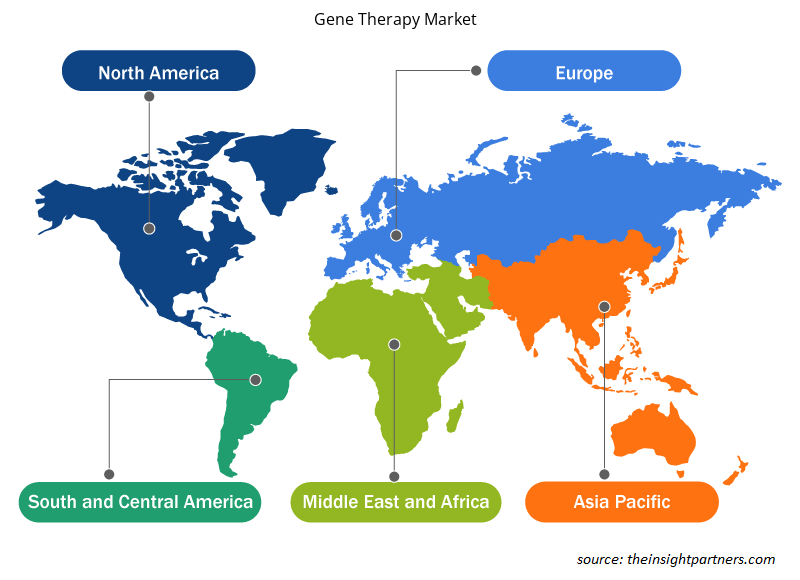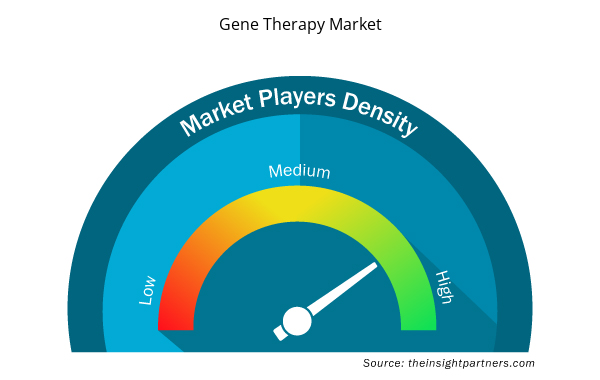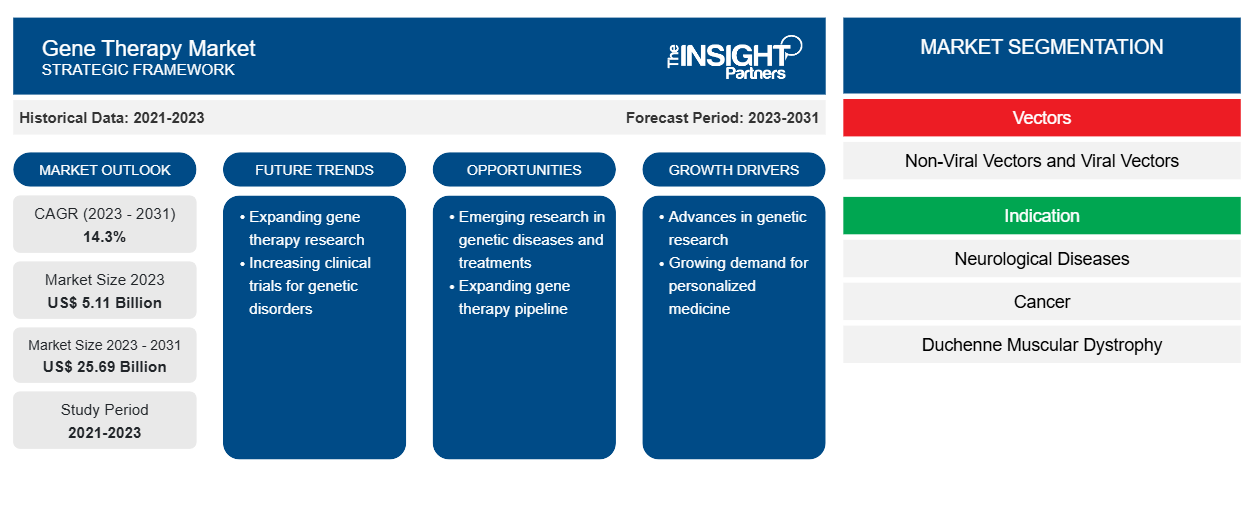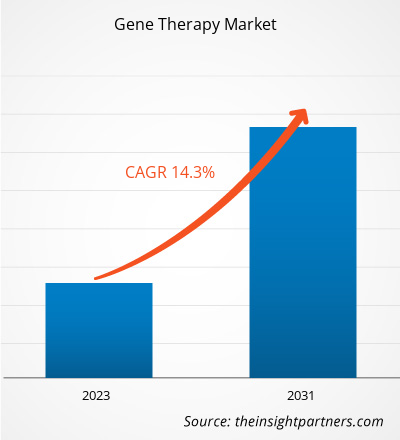[Rapporto di ricerca] Si prevede che il mercato della terapia genica raggiungerà i 25,69 miliardi di dollari entro il 2031, rispetto ai 5,11 miliardi di dollari del 2023; si stima che il mercato registrerà un CAGR del 14,3% nel periodo 2023-2031.
Approfondimenti di mercato e opinioni degli analisti:
La terapia genica è un processo per il trattamento delle malattie mediante l'inattivazione di un gene che causa la malattia, la sostituzione di un gene che causa la malattia con una copia sana del gene o l'introduzione di un gene nuovo o modificato nel corpo per aiutare a curare e prevenire la malattia. La terapia genica può essere classificata in terapia genica in vivo ed ex vivo. La terapia genica mira a sostituire o correggere i geni difettosi con quelli normali, consentendo al corpo di produrre le proteine o gli enzimi corretti necessari per il normale funzionamento, che possono potenzialmente curare la causa sottostante delle malattie. La crescente prevalenza di malattie genetiche e cancro in tutto il mondo e il crescente numero di approvazioni FDA di terapie geniche favoriscono la crescita del mercato della terapia genica . Inoltre, le tendenze del mercato della terapia genica includono progressi nelle tecnologie di terapia genica che favoriranno la crescita del mercato in futuro.
Fattori di crescita:
I progressi nella biotecnologia hanno portato allo sviluppo di trattamenti per un'ampia gamma di indicazioni. Le terapie geniche vengono utilizzate per trattare varie malattie, come cancro, disturbi neurologici e disturbi genetici. A livello globale, le terapie geniche vengono ampiamente adottate grazie alla disponibilità di prodotti approvati dalla Food and Drug Administration (FDA) statunitense. Di seguito sono riportati alcuni esempi di prodotti di terapia genica approvati dalla FDA negli ultimi anni:
- A dicembre 2023, la FDA ha approvato due terapie geniche basate sulle cellule per l'anemia falciforme. Lyfgenia (lovotibeglogene autotemcel) di Bluebird Bio è stato autorizzato per i pazienti affetti da anemia falciforme di età pari o superiore a 12 anni con una storia di eventi vaso-occlusivi. È stato approvato insieme a Casgevy (exagamglogene autotemcel), di Vertex Pharmaceuticals e CRISPR Therapeutics.
- A giugno 2023, la FDA ha approvato Roctavian, una terapia genica basata su un vettore virale adeno-associato per il trattamento di adulti con emofilia A grave senza anticorpi preesistenti al sierotipo 5 del virus adeno-associato. L'emofilia A ereditaria è un grave disturbo emorragico che si verifica a causa di una mutazione genetica, responsabile della produzione del fattore VIII (FVIII), una proteina che consente la coagulazione del sangue. Roctavian è un prodotto di terapia genica monouso che contiene un vettore virale che trasporta un gene per il fattore VIII della coagulazione.
- Nel giugno 2023, la FDA ha approvato Elevidys, la prima terapia genica per il trattamento della distrofia muscolare di Duchenne nei pazienti pediatrici di età compresa tra 4 e 5 anni con una mutazione confermata nel gene della distrofia muscolare di Duchenne e che non presentano una condizione medica preesistente che impedisca il trattamento con questa terapia.
- Nel novembre 2022, la FDA ha approvato HEMGENIX, prodotto da CSL Behring LLC, una terapia genica ricombinante basata sul virus adeno-associato di tipo 5 per il trattamento di pazienti adulti affetti da alcuni tipi di emofilia B.
Pertanto, la crescente approvazione di queste terapie geniche sta alimentando la crescita del mercato della terapia genica.
Personalizza questo report in base alle tue esigenze
Riceverai la personalizzazione gratuita di qualsiasi report, comprese parti di questo report, o analisi a livello nazionale, pacchetto dati Excel, oltre a usufruire di grandi offerte e sconti per start-up e università
- Scopri le principali tendenze di mercato in questo rapporto.Questo campione GRATUITO includerà analisi di dati che spaziano dalle tendenze di mercato alle stime e alle previsioni.
Segmentazione e ambito del report:
L'analisi del mercato della terapia genica è stata condotta considerando i seguenti segmenti: vettori, indicazione, modalità di somministrazione e geografia. In base ai vettori, il mercato è categorizzato in vettori non virali e vettori virali. In termini di indicazione, il mercato è classificato in malattie neurologiche, cancro, distrofia muscolare di Duchenne, malattie epatologiche e altre indicazioni. In termini di modalità di somministrazione, il mercato è biforcato in in vivo ed ex vivo. L'ambito del rapporto di mercato sulla terapia genica copre Nord America (Stati Uniti, Canada e Messico), Europa (Francia, Germania, Regno Unito, Spagna, Italia e resto d'Europa), Asia Pacifico (Cina, Giappone, India, Australia, Corea del Sud e resto dell'Asia Pacifico), Medio Oriente e Africa (Arabia Saudita, Sud Africa, Emirati Arabi Uniti e resto del Medio Oriente e Africa) e Sud e Centro America (Brasile, Argentina e resto del Sud e Centro America).
Analisi segmentale:
Il mercato della terapia genica, per vettori, è categorizzato in vettori non virali e vettori virali. Il segmento dei vettori virali ha detenuto una quota di mercato significativa nel 2023. Si prevede che registrerà un CAGR più elevato nel mercato nel periodo 2023-2030.
In base all'indicazione, il mercato è classificato in malattie neurologiche, cancro, distrofia muscolare di Duchenne, malattie epatologiche e altre indicazioni. Il segmento del cancro ha detenuto una quota di mercato significativa della terapia genica nel 2023 e si stima che registrerà il CAGR più elevato nel periodo 2023-2030.
In base alla modalità di somministrazione, il mercato è segmentato in in vivo ed ex vivo. Il segmento in vivo ha detenuto una quota di mercato significativa della terapia genica nel 2023 e si prevede che registrerà un CAGR più elevato nel periodo 2023-2030. La terapia genica in vivo consente un trattamento sistematico, il che implica che può raggiungere più siti e organi in tutto il corpo. Ciò è particolarmente utile per le malattie che colpiscono più aree o hanno segni sistematici, consentendo un approccio terapeutico completo. Inoltre, lo sviluppo di tecnologie di somministrazione avanzate, come vettori virali, nanoparticelle e vettori a base di lipidi, ha migliorato l'efficacia e la specificità della terapia in vivo. Questi progressi potenziano la somministrazione mirata di materiale genetico e migliorano la sicurezza e l'efficacia della terapia.
Analisi regionale:
Geograficamente, il mercato della terapia genica è segmentato in Nord America, Europa, Asia Pacifico, Sud e Centro America e Medio Oriente e Africa. Nel 2023, il Nord America ha conquistato una quota significativa del mercato. Nel 2023, gli Stati Uniti hanno dominato il mercato della terapia genica in questa regione. La crescita del mercato in Nord America è attribuita alla crescente prevalenza di disturbi genetici, al crescente numero di pazienti affetti da cancro, all'aumento dei finanziamenti governativi, alla crescente adozione della terapia genica avanzata per il trattamento delle malattie e alla crescente approvazione del prodotto.
Secondo i Centers for Disease Control and Prevention (CDC), nel 2020 sono stati diagnosticati circa 1.603.844 nuovi casi di cancro, con 602.347 decessi per cancro negli Stati Uniti. Per ogni 100.000 individui, sono stati segnalati 403 nuovi casi di cancro. Inoltre, secondo l'Agenzia internazionale per la ricerca sul cancro, si prevede che i nuovi casi di cancro raggiungeranno i 30,2 milioni entro il 2040. Secondo le stime dell'US Government Accountability Office pubblicate nell'ottobre 2021, circa 25-30 milioni di persone soffrono di malattie rare nel paese; quasi il 50% dei pazienti con malattie rare sono bambini. Le malattie rare sono spesso il risultato di una mutazione genetica; si stima che l'80% delle malattie rare sia genetico.
Secondo un aggiornamento di ottobre 2021 dei National Institutes of Health, 10 aziende farmaceutiche e 5 organizzazioni non profit hanno collaborato per accelerare lo sviluppo di terapie geniche per i 30 milioni di americani che soffrono di malattie rare. La FDA statunitense ha approvato 7 farmaci per la terapia cellulare e genica, con una pipeline di nuovi prodotti che ha raggiunto circa 1.200 terapie sperimentali. Metà di queste sono in fase 2 di sperimentazione clinica, con stime di crescita delle vendite annuali pari al 15% per le terapie cellulari e al 30% per le terapie geniche, secondo le stime del rapporto 2023 di Chemical & Engineering News. Tutti questi fattori sopra menzionati contribuiscono alla crescita delle dimensioni del mercato della terapia genica nella regione.
Approfondimenti regionali sul mercato della terapia genica
Le tendenze regionali e i fattori che influenzano il mercato della terapia genica durante il periodo di previsione sono stati ampiamente spiegati dagli analisti di Insight Partners. Questa sezione discute anche i segmenti e la geografia del mercato della terapia genica in Nord America, Europa, Asia Pacifico, Medio Oriente e Africa e America meridionale e centrale.

- Ottieni i dati specifici regionali per il mercato della terapia genica
Ambito del rapporto di mercato sulla terapia genica
| Attributo del report | Dettagli |
|---|---|
| Dimensioni del mercato nel 2023 | 5,11 miliardi di dollari USA |
| Dimensioni del mercato entro il 2031 | 25,69 miliardi di dollari USA |
| CAGR globale (2023-2031) | 14,3% |
| Dati storici | 2021-2023 |
| Periodo di previsione | 2023-2031 |
| Segmenti coperti | Per vettori
|
| Regioni e Paesi coperti | America del Nord
|
| Leader di mercato e profili aziendali chiave |
|
Densità degli attori del mercato della terapia genica: comprendere il suo impatto sulle dinamiche aziendali
Il mercato della terapia genica sta crescendo rapidamente, spinto dalla crescente domanda degli utenti finali dovuta a fattori quali l'evoluzione delle preferenze dei consumatori, i progressi tecnologici e una maggiore consapevolezza dei benefici del prodotto. Con l'aumento della domanda, le aziende stanno ampliando le loro offerte, innovando per soddisfare le esigenze dei consumatori e capitalizzando sulle tendenze emergenti, il che alimenta ulteriormente la crescita del mercato.
La densità degli operatori di mercato si riferisce alla distribuzione di aziende o società che operano in un particolare mercato o settore. Indica quanti concorrenti (operatori di mercato) sono presenti in un dato spazio di mercato in relazione alle sue dimensioni o al valore di mercato totale.
Le principali aziende che operano nel mercato della terapia genica sono:
- Novartis AG
- Astellas Pharma Inc.
- Società Bristol-Myers Squibb
- Azienda agricola Bluebird Bio Inc.
- Sanofi
Disclaimer : le aziende elencate sopra non sono classificate secondo un ordine particolare.

- Ottieni una panoramica dei principali attori del mercato della terapia genica
Sviluppi del settore e opportunità future:
Alcune iniziative intraprese dagli operatori del mercato operanti indi seguito sono elencati i mercati globali della terapia genica:
- Nel gennaio 2022, Ori Biotech Ltd si è assicurata oltre 100 milioni di dollari in un round di finanziamento di serie B sottoscritto in eccesso per introdurre sul mercato un'innovativa piattaforma di produzione di terapia genica e cellulare.
- Nel gennaio 2020, Astellas Pharma Inc. ha acquisito Audentes Therapeutics, Inc. L'acquisizione consente alla società risultante dalla fusione di diventare un leader mondiale nella medicina genetica basata sugli AAV.
Scenario competitivo e aziende chiave:
Le previsioni di mercato della terapia genica possono aiutare gli stakeholder a pianificare le loro strategie di crescita. Novartis AG, Astellas Pharma Inc., Bristol-Myers Squibb Company, Bluebird Bio Inc., CSL Behring, Sanofi, F. Hoffmann-La Roche Ltd, Daiichi Sankyo, Biogen e Oxford Biomedica sono tra i principali attori profilati nel report di mercato della terapia genica. Queste aziende si concentrano sull'introduzione di nuovi prodotti ad alta tecnologia, sui progressi nei prodotti esistenti e sulle espansioni geografiche per soddisfare la crescente domanda dei consumatori in tutto il mondo.
- Analisi storica (2 anni), anno base, previsione (7 anni) con CAGR
- Analisi PEST e SWOT
- Valore/volume delle dimensioni del mercato - Globale, regionale, nazionale
- Industria e panorama competitivo
- Set di dati Excel


- Wire Harness Market
- Hydrocephalus Shunts Market
- USB Device Market
- Nuclear Decommissioning Services Market
- Health Economics and Outcome Research (HEOR) Services Market
- Long Read Sequencing Market
- Sterilization Services Market
- Ketogenic Diet Market
- Trade Promotion Management Software Market
- Single-Use Negative Pressure Wound Therapy Devices Market

Report Coverage
Revenue forecast, Company Analysis, Industry landscape, Growth factors, and Trends

Segment Covered
This text is related
to segments covered.

Regional Scope
North America, Europe, Asia Pacific, Middle East & Africa, South & Central America

Country Scope
This text is related
to country scope.
Domande frequenti
The gene therapy market majorly consists of the players, including Novartis AG, Astellas Pharma Inc., Bristol-Myers Squibb Company, Bluebird Bio Inc., CSL Behring, Sanofi, F. Hoffmann-La Roche Ltd, Daiichi Sankyo, Biogen, and Oxford Biomedica.
The gene therapy market was valued at US$ 5.11 billion in 2023.
The factors driving the growth of the gene therapy market include the increasing burden of genetic diseases and the rising number of FDA approvals of gene therapies. However, the high cost of gene therapy products hampers the growth of the gene therapy market.
The gene therapy market is expected to be valued at US$ 25.69 billion in 2031.
The global gene therapy market is segmented based on vectors, indication, and delivery mode. Based on indication, the gene therapy market is categorized into neurological diseases, cancer, Duchenne muscular dystrophy, hepatological diseases, and other indications. The cancer segment held a significant market share in 2023 and is anticipated to record the highest CAGR in the market during 2023–2031.
Gene therapy is a process for the treatment of diseases by inactivating a disease-causing gene, replacing a disease-causing gene with a healthy copy of the gene, or introducing a new or modified gene into the body to help treat and prevent the disease.
Trends and growth analysis reports related to Life Sciences : READ MORE..
The List of Companies - Gene Therapy Market
- Novartis AG
- Astellas Pharma Inc.
- Bristol-Myers Squibb Company
- Bluebird Bio Inc.
- Sanofi
- F. Hoffmann-La Roche Ltd
- Daiichi Sankyo
- CSL Behring
- Biogen
- Oxford Biomedica.
The Insight Partners performs research in 4 major stages: Data Collection & Secondary Research, Primary Research, Data Analysis and Data Triangulation & Final Review.
- Data Collection and Secondary Research:
As a market research and consulting firm operating from a decade, we have published and advised several client across the globe. First step for any study will start with an assessment of currently available data and insights from existing reports. Further, historical and current market information is collected from Investor Presentations, Annual Reports, SEC Filings, etc., and other information related to company’s performance and market positioning are gathered from Paid Databases (Factiva, Hoovers, and Reuters) and various other publications available in public domain.
Several associations trade associates, technical forums, institutes, societies and organization are accessed to gain technical as well as market related insights through their publications such as research papers, blogs and press releases related to the studies are referred to get cues about the market. Further, white papers, journals, magazines, and other news articles published in last 3 years are scrutinized and analyzed to understand the current market trends.
- Primary Research:
The primarily interview analysis comprise of data obtained from industry participants interview and answers to survey questions gathered by in-house primary team.
For primary research, interviews are conducted with industry experts/CEOs/Marketing Managers/VPs/Subject Matter Experts from both demand and supply side to get a 360-degree view of the market. The primary team conducts several interviews based on the complexity of the markets to understand the various market trends and dynamics which makes research more credible and precise.
A typical research interview fulfils the following functions:
- Provides first-hand information on the market size, market trends, growth trends, competitive landscape, and outlook
- Validates and strengthens in-house secondary research findings
- Develops the analysis team’s expertise and market understanding
Primary research involves email interactions and telephone interviews for each market, category, segment, and sub-segment across geographies. The participants who typically take part in such a process include, but are not limited to:
- Industry participants: VPs, business development managers, market intelligence managers and national sales managers
- Outside experts: Valuation experts, research analysts and key opinion leaders specializing in the electronics and semiconductor industry.
Below is the breakup of our primary respondents by company, designation, and region:

Once we receive the confirmation from primary research sources or primary respondents, we finalize the base year market estimation and forecast the data as per the macroeconomic and microeconomic factors assessed during data collection.
- Data Analysis:
Once data is validated through both secondary as well as primary respondents, we finalize the market estimations by hypothesis formulation and factor analysis at regional and country level.
- Macro-Economic Factor Analysis:
We analyse macroeconomic indicators such the gross domestic product (GDP), increase in the demand for goods and services across industries, technological advancement, regional economic growth, governmental policies, the influence of COVID-19, PEST analysis, and other aspects. This analysis aids in setting benchmarks for various nations/regions and approximating market splits. Additionally, the general trend of the aforementioned components aid in determining the market's development possibilities.
- Country Level Data:
Various factors that are especially aligned to the country are taken into account to determine the market size for a certain area and country, including the presence of vendors, such as headquarters and offices, the country's GDP, demand patterns, and industry growth. To comprehend the market dynamics for the nation, a number of growth variables, inhibitors, application areas, and current market trends are researched. The aforementioned elements aid in determining the country's overall market's growth potential.
- Company Profile:
The “Table of Contents” is formulated by listing and analyzing more than 25 - 30 companies operating in the market ecosystem across geographies. However, we profile only 10 companies as a standard practice in our syndicate reports. These 10 companies comprise leading, emerging, and regional players. Nonetheless, our analysis is not restricted to the 10 listed companies, we also analyze other companies present in the market to develop a holistic view and understand the prevailing trends. The “Company Profiles” section in the report covers key facts, business description, products & services, financial information, SWOT analysis, and key developments. The financial information presented is extracted from the annual reports and official documents of the publicly listed companies. Upon collecting the information for the sections of respective companies, we verify them via various primary sources and then compile the data in respective company profiles. The company level information helps us in deriving the base number as well as in forecasting the market size.
- Developing Base Number:
Aggregation of sales statistics (2020-2022) and macro-economic factor, and other secondary and primary research insights are utilized to arrive at base number and related market shares for 2022. The data gaps are identified in this step and relevant market data is analyzed, collected from paid primary interviews or databases. On finalizing the base year market size, forecasts are developed on the basis of macro-economic, industry and market growth factors and company level analysis.
- Data Triangulation and Final Review:
The market findings and base year market size calculations are validated from supply as well as demand side. Demand side validations are based on macro-economic factor analysis and benchmarks for respective regions and countries. In case of supply side validations, revenues of major companies are estimated (in case not available) based on industry benchmark, approximate number of employees, product portfolio, and primary interviews revenues are gathered. Further revenue from target product/service segment is assessed to avoid overshooting of market statistics. In case of heavy deviations between supply and demand side values, all thes steps are repeated to achieve synchronization.
We follow an iterative model, wherein we share our research findings with Subject Matter Experts (SME’s) and Key Opinion Leaders (KOLs) until consensus view of the market is not formulated – this model negates any drastic deviation in the opinions of experts. Only validated and universally acceptable research findings are quoted in our reports.
We have important check points that we use to validate our research findings – which we call – data triangulation, where we validate the information, we generate from secondary sources with primary interviews and then we re-validate with our internal data bases and Subject matter experts. This comprehensive model enables us to deliver high quality, reliable data in shortest possible time.


 Ottieni un campione gratuito per questo repot
Ottieni un campione gratuito per questo repot